Kotlin学习手记——协程进阶
Posted 川峰
tags:
篇首语:本文由小常识网(cha138.com)小编为大家整理,主要介绍了Kotlin学习手记——协程进阶相关的知识,希望对你有一定的参考价值。
作用域:

顶级:


coroutineScope表示协同作用域,coroutineScope内部的协程出现异常可以挂掉外部协程,会向外部传播,外部协程挂掉也会挂掉子协程,即双向传播。
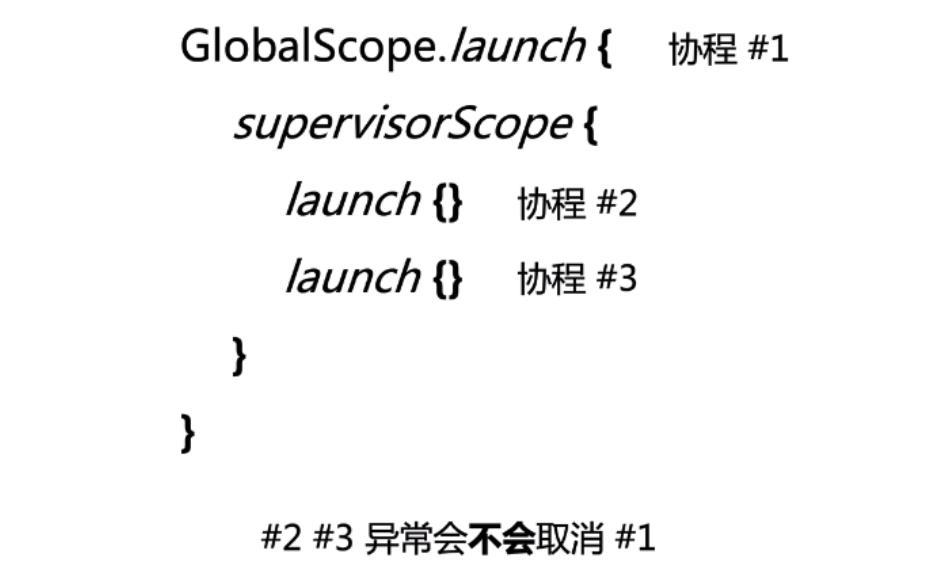
supervisorScope表示主从作用域,supervisorScope内部的协程挂掉不会影响外部的协程继续运行,它就像一道防火墙,隔离了异常,保证程序健壮,但是如果外部协程挂掉还是可以取消子协程的,即单向传播。
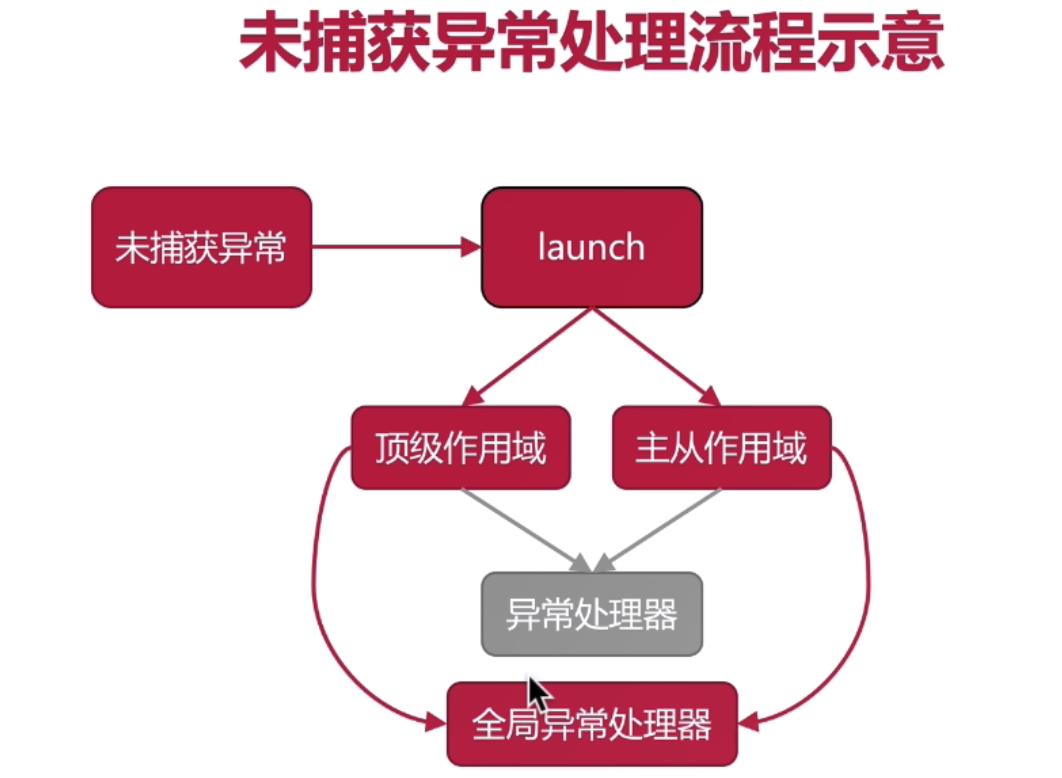

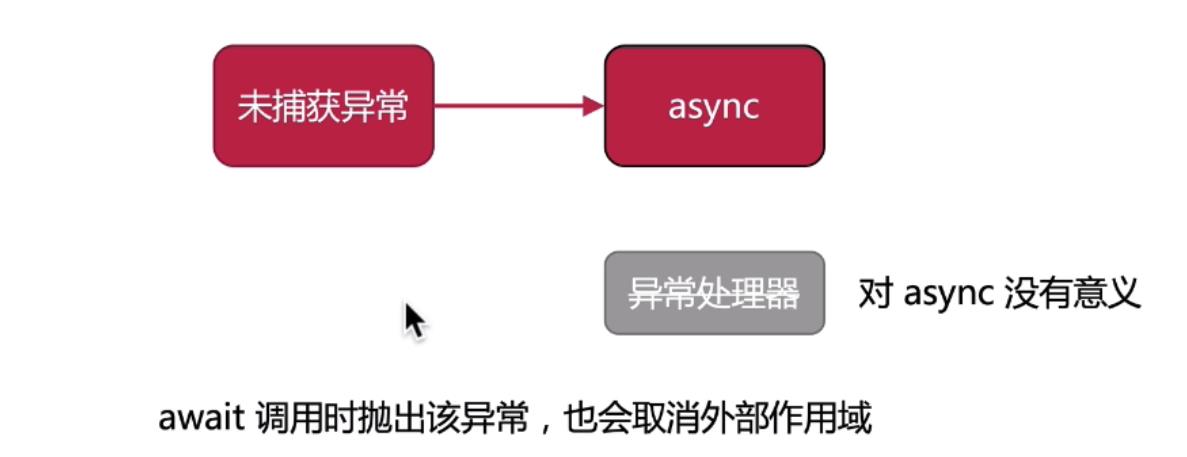
简单总结就是,主从关系:无法坑爹,爹可以坑儿子。协同关系:可以坑爹,可以坑儿子,互相坑。

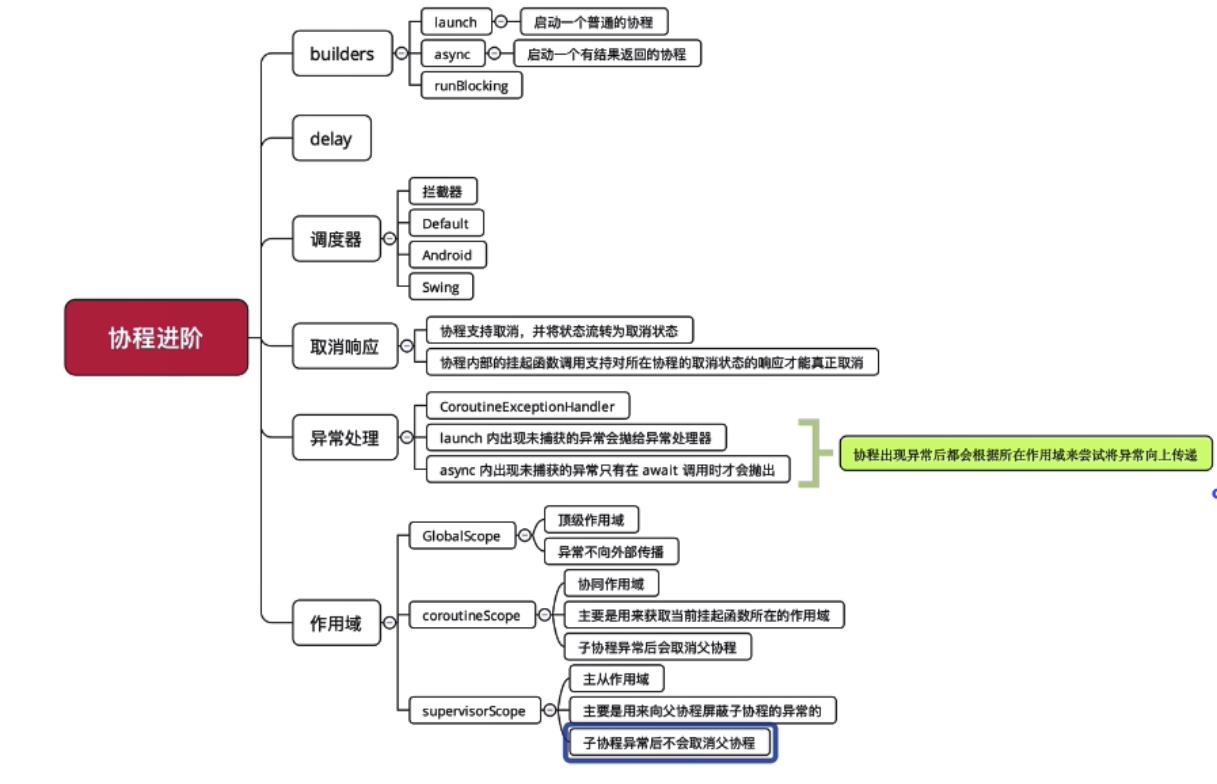
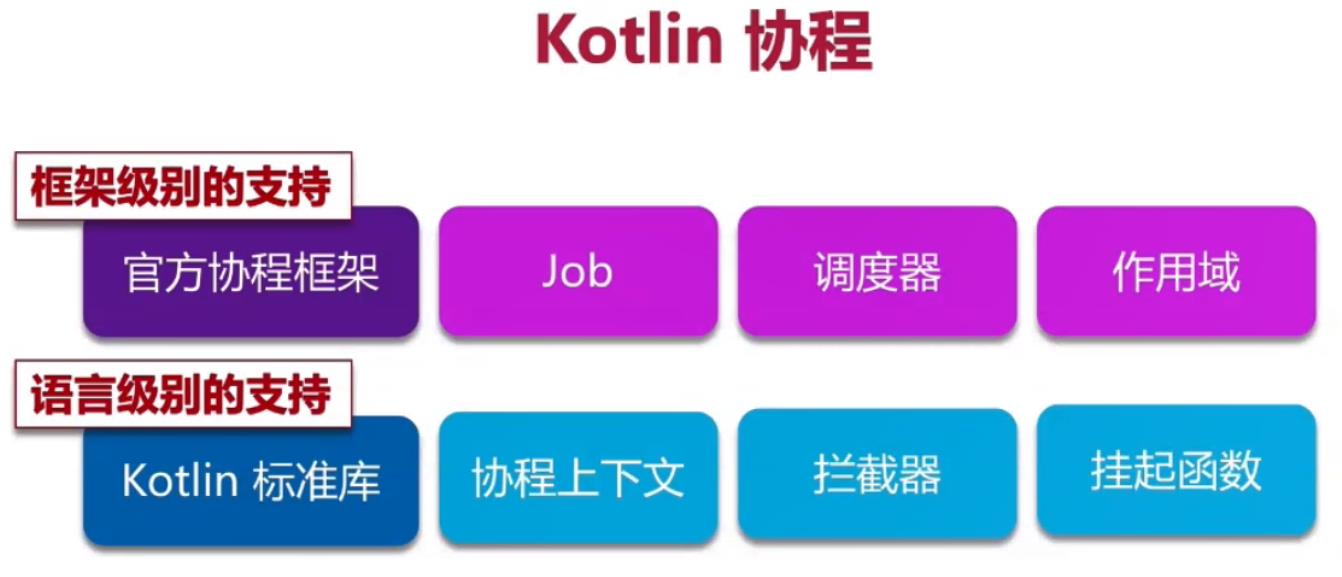

如果是应用的话,主要掌握框架级别的使用即可,语言级别的支持api来源于标准库,写起来比较麻烦也非常难理解。
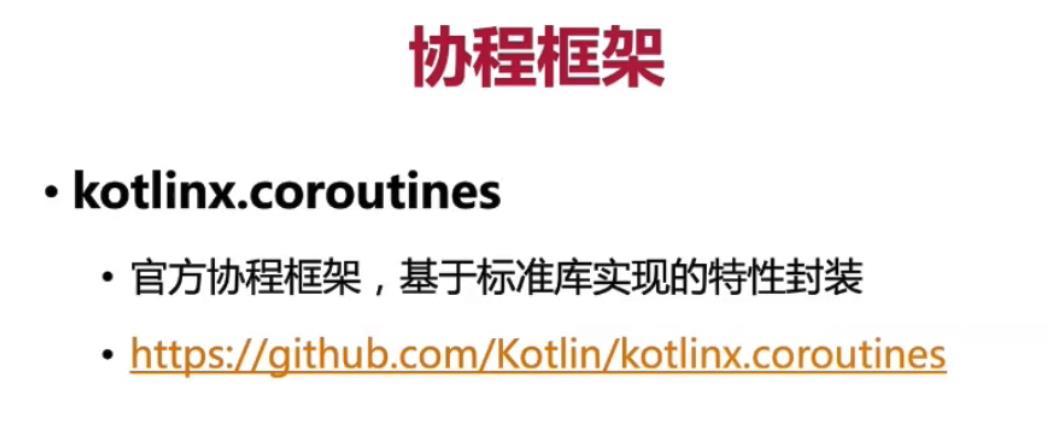
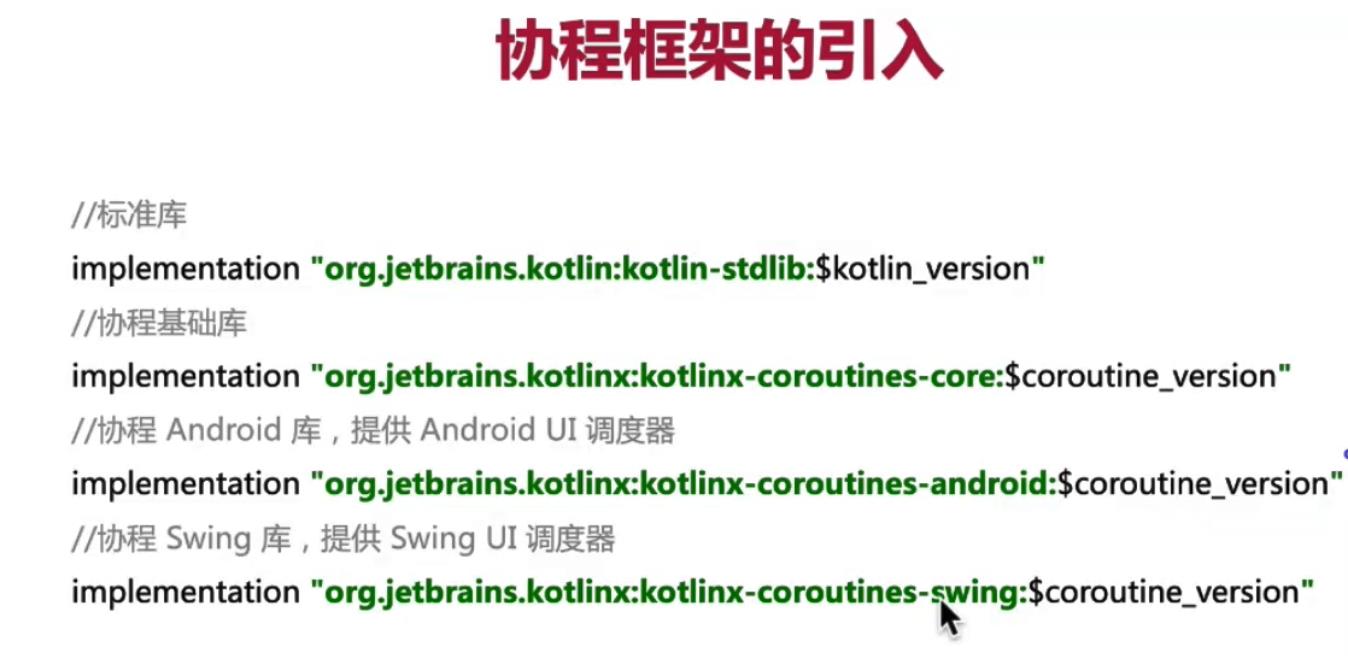
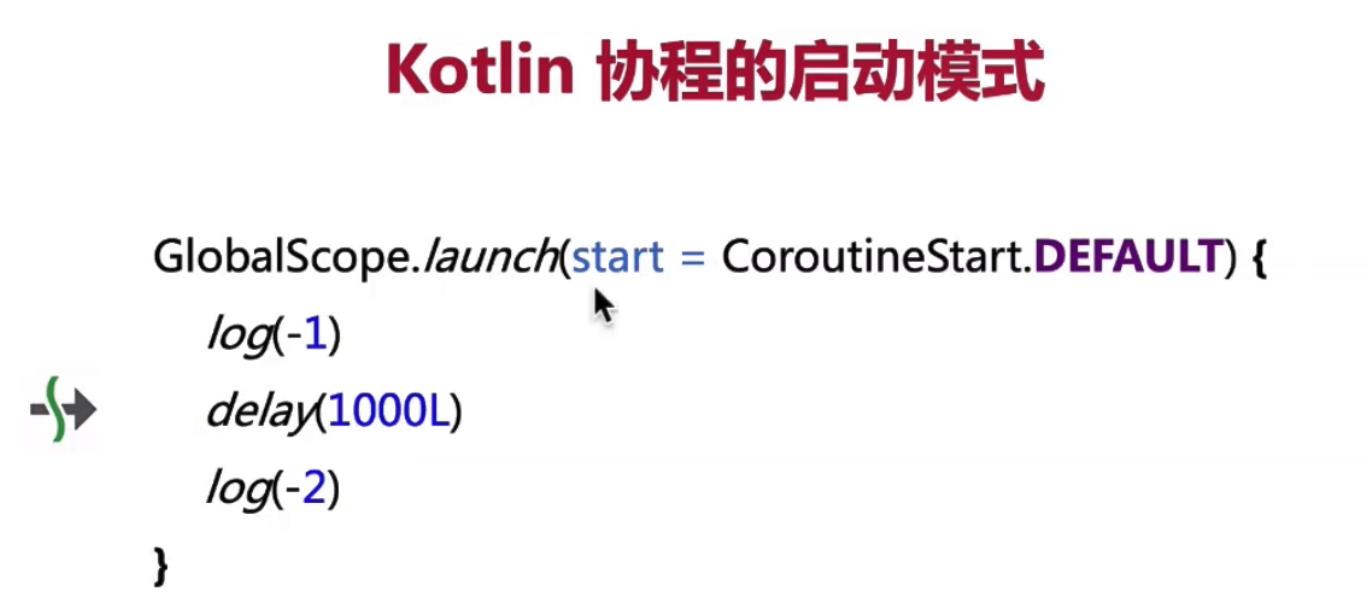
这里launch会进行一次调度 ,delay会进行一次调度,每次调度完成会执行一次resume, 最终协程体执行完毕会执行一次resume, 所以内部有n个挂起点的协程体会执行n+2次resume.

DEFAULT 立即开始调度 和 UNDISPATCHED 立即开始执行协程体,这两个含义的区别是 DEFAULT 只是立即启动协程执行可能是异步的,而后者是直接执行协程体中的代码了。LAZY 是先创建协程体,然后在未来的某个时刻才去启动执行。
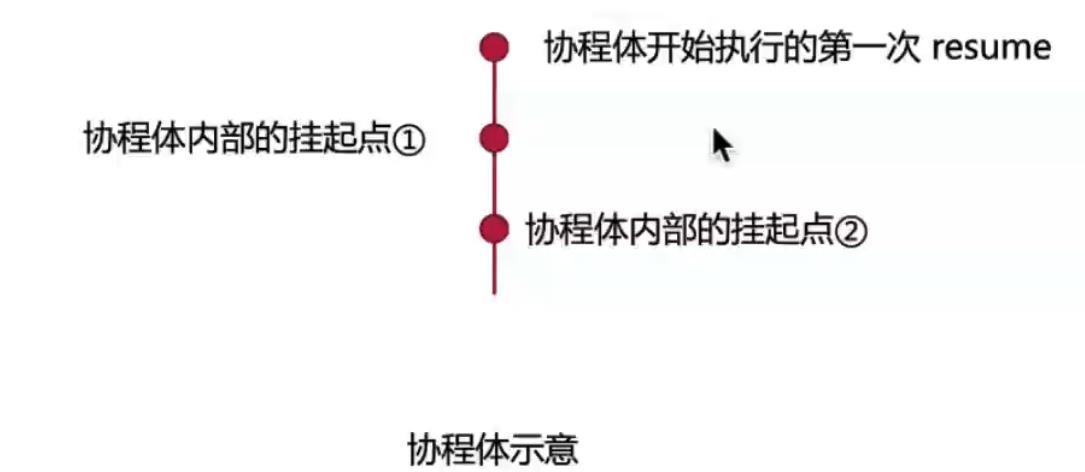

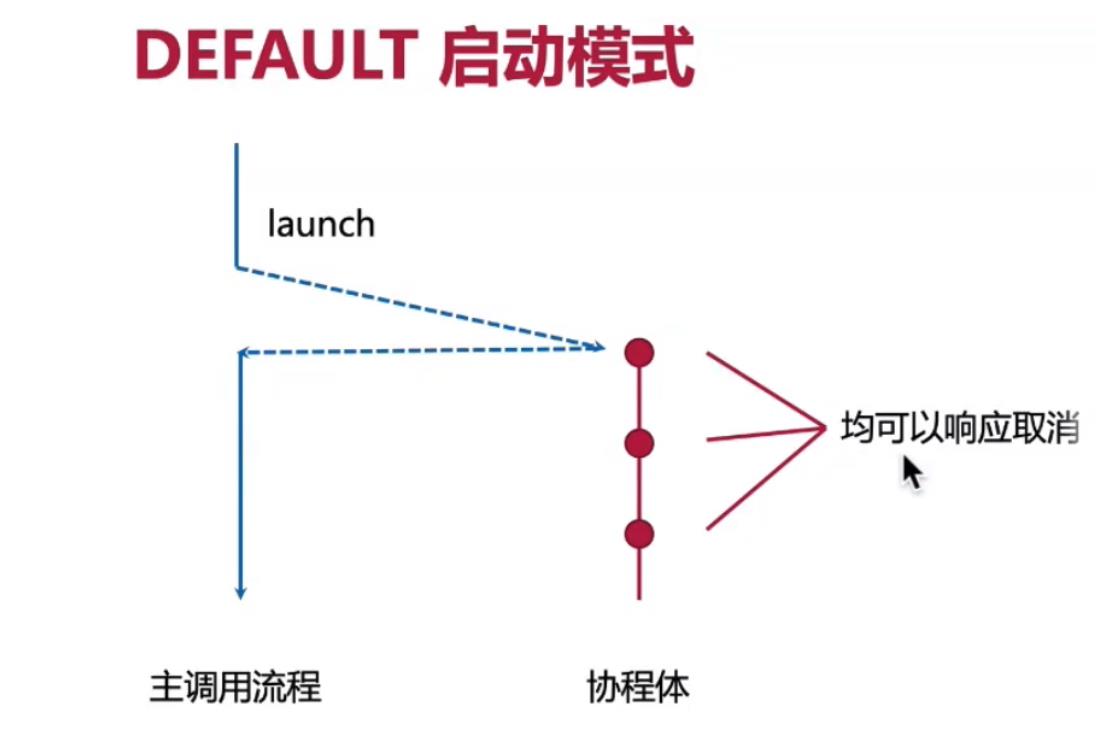

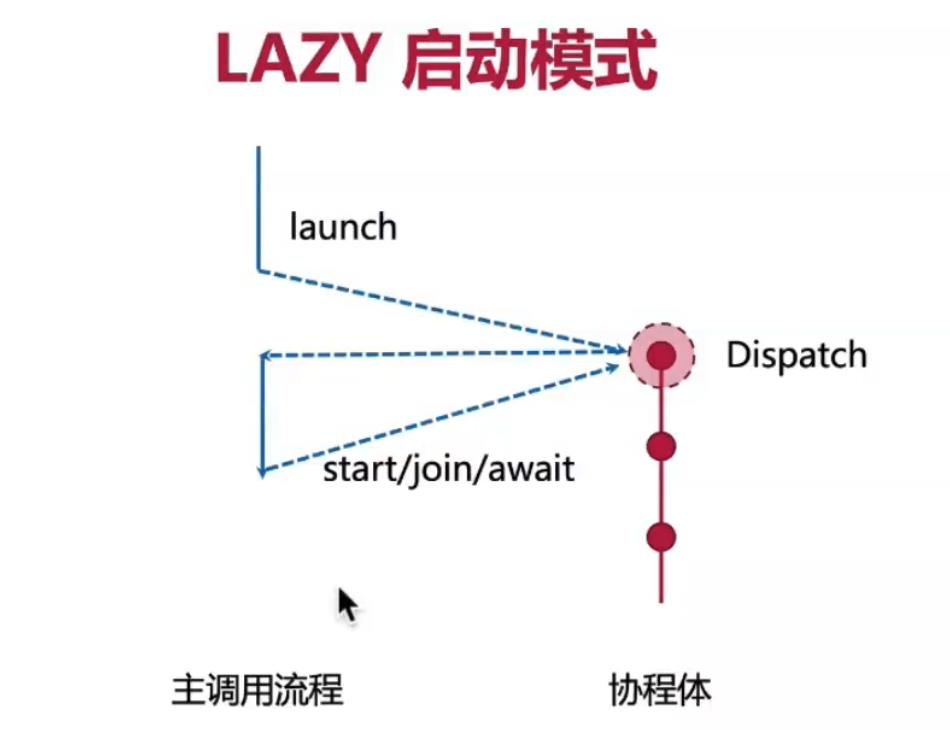

UNDISPATCHED 立即开始执行协程体,如果遇到挂起点,就切回主流程了,后面的协程体继续执行在单独的调度器。
import kotlinx.coroutines.*
@ExperimentalCoroutinesApi
suspend fun main()
println("start")
testDefaultMode()
// testAtomicMode()
// testLazyMode()
// testUNDISPATCHEDMode()
println("finish")
suspend fun testDefaultMode()
val defaultMode = GlobalScope.launch(start = CoroutineStart.DEFAULT)
println("aaa")
delay(3000)
println("bbb")
println("222")
defaultMode.join()
@ExperimentalCoroutinesApi
suspend fun testAtomicMode()
val defaultMode = GlobalScope.launch(start = CoroutineStart.ATOMIC)
println("aaa")
delay(3000)
println("bbb")
println("222")
defaultMode.join()
suspend fun testLazyMode()
val defaultMode = GlobalScope.async(start = CoroutineStart.LAZY)
println("aaa")
delay(3000)
println("bbb")
println("222")
defaultMode.await()
@ExperimentalCoroutinesApi
suspend fun testUNDISPATCHEDMode()
val defaultMode = GlobalScope.launch(start = CoroutineStart.UNDISPATCHED)
println("aaa")
delay(3000)
println("bbb")
println("222")
defaultMode.join()
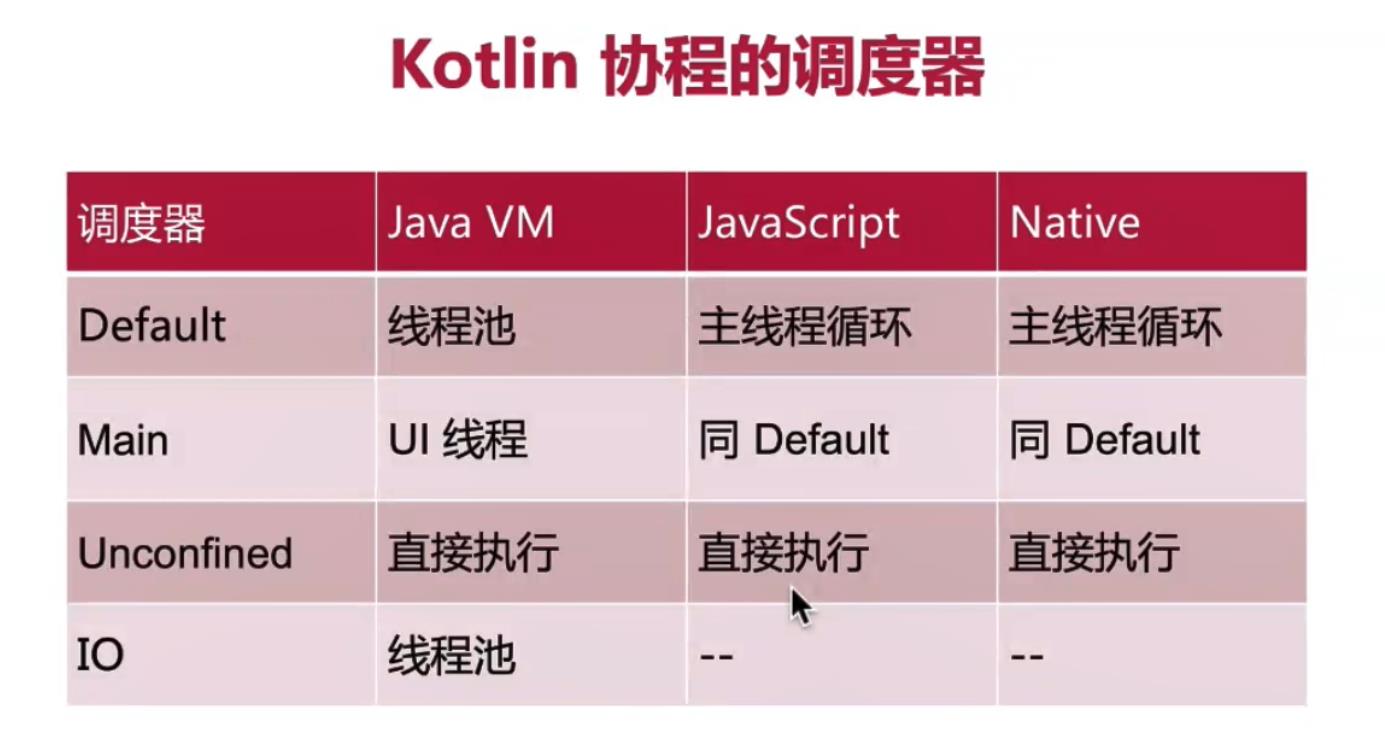
Default和IO线程的区别,IO内部多了一个队列的维护

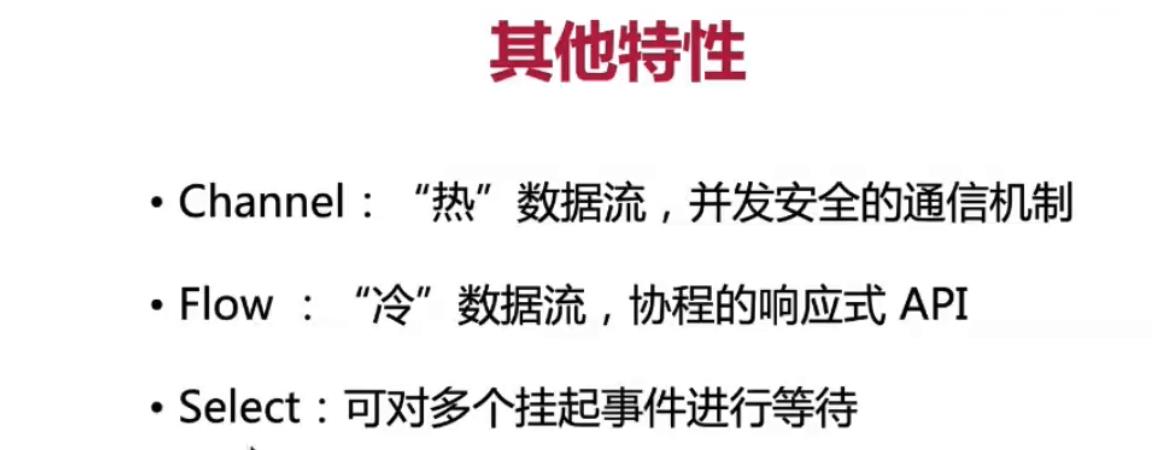


回调转协程的完整写法:
import com.bennyhuo.kotlin.coroutines.advanced.common.gitHubServiceApi
import kotlinx.coroutines.suspendCancellableCoroutine
import retrofit2.Call
import retrofit2.Callback
import retrofit2.HttpException
import retrofit2.Response
import kotlin.coroutines.resume
import kotlin.coroutines.resumeWithException
suspend fun <T> Call<T>.await(): T = suspendCancellableCoroutine //可取消
continuation ->
continuation.invokeOnCancellation
cancel() //调用retrofit的取消方法
enqueue(object: Callback<T>
override fun onFailure(call: Call<T>, t: Throwable)
continuation.resumeWithException(t)
override fun onResponse(call: Call<T>, response: Response<T>)
response.takeIf it.isSuccessful ?.body()?.also continuation.resume(it)
?: continuation.resumeWithException(HttpException(response))
)
suspend fun main()
val user = gitHubServiceApi.getUserCallback("flycumt").await()
println(user)
也可以不自己写,retrofit的api中本身有实现await()方法,awaitResponse()方法等。
CompletableFuture 添加回调的写法:
import com.bennyhuo.kotlin.coroutines.advanced.utils.log
import kotlinx.coroutines.suspendCancellableCoroutine
import java.util.concurrent.CompletableFuture
import java.util.concurrent.ExecutionException
import kotlin.coroutines.resume
import kotlin.coroutines.resumeWithException
suspend fun main()
val result = CompletableFuture.supplyAsync
3
.await()
log(result)
suspend fun <T> CompletableFuture<T>.await(): T
if(isDone)
try
return get()
catch (e: ExecutionException)
throw e.cause ?: e
return suspendCancellableCoroutine //可取消
cancellableContinuation ->
cancellableContinuation.invokeOnCancellation
cancel(true) //取消
whenComplete value, throwable ->
if(throwable == null)
cancellableContinuation.resume(value)
else
cancellableContinuation.resumeWithException(throwable.cause ?: throwable)
CompletableFuture本身也有实现await()方法。
模仿给Handler扩展添加可取消的支持:
suspend fun <T> Handler.run(block: () -> T) = suspendCoroutine<T> continuation ->
post
try
continuation.resume(block())
catch (e: Exception)
continuation.resumeWithException(e)
suspend fun <T> Handler.runDelay(delay: Long, block: () -> T) = suspendCancellableCoroutine<T> continuation ->
val message = Message.obtain(this) //Message obtain(Handler h, Runnable callback)
try
continuation.resume(block())
catch (e: Exception)
continuation.resumeWithException(e)
.also
it.obj = continuation //message.obj
continuation.invokeOnCancellation
removeCallbacksAndMessages(continuation) //通过Handler的removeCallbacksAndMessages方法来取消回调, 参数就是前面设置的message.obj的值
sendMessageDelayed(message, delay)
suspend fun main()
Looper.prepareMainLooper()
GlobalScope.launch
val handler = Handler(Looper.getMainLooper())
val result = handler.run "Hello"
val delayedResult = handler.runDelay(5000) "World"
log(result, delayedResult)
Looper.getMainLooper().quit()
Looper.loop()
这个例子的主要意图是,Hanlder可以通过定义扩展函数的方式来延时获取一些东西,比如Activity刚创建的时候,拿不到view的宽和高,就可以使用这种方法。
上面三个例子主要是针对可取消的写法,如果实际用,不用自己写,直接导库就行。
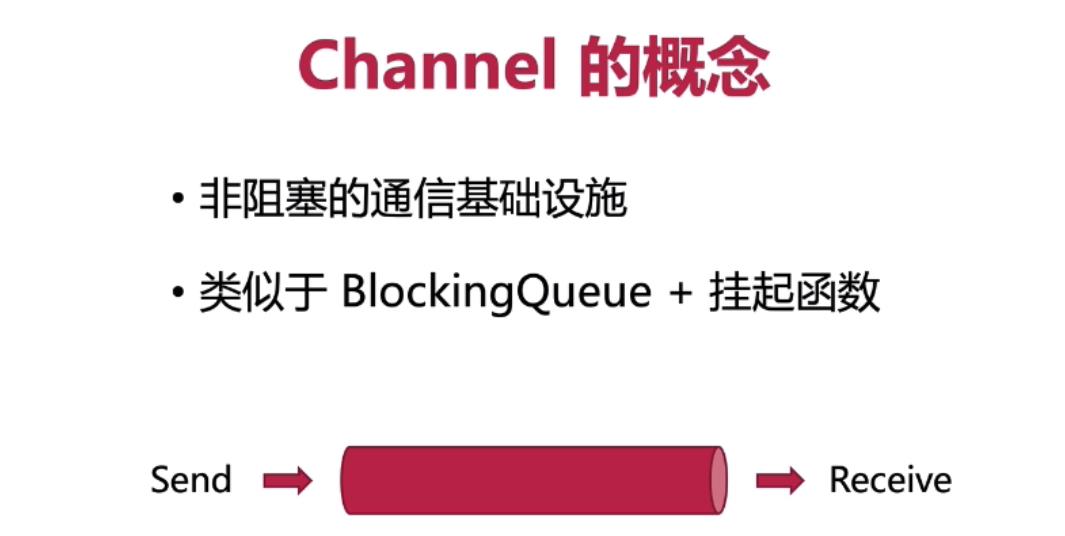
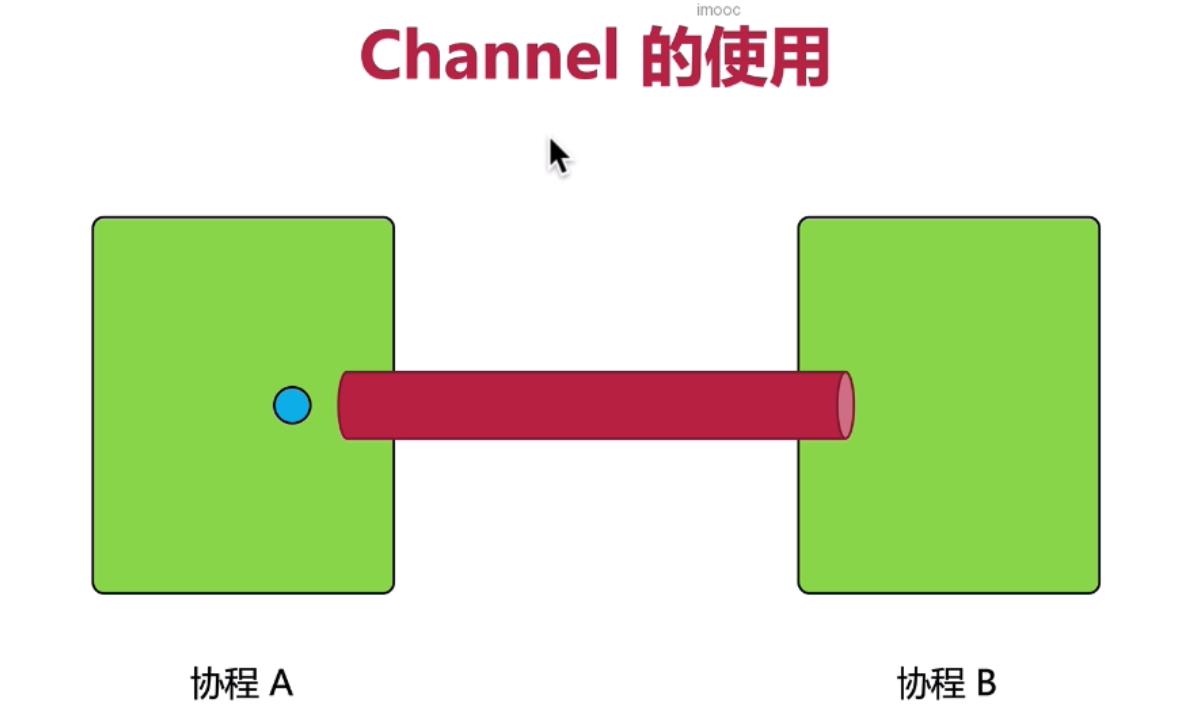
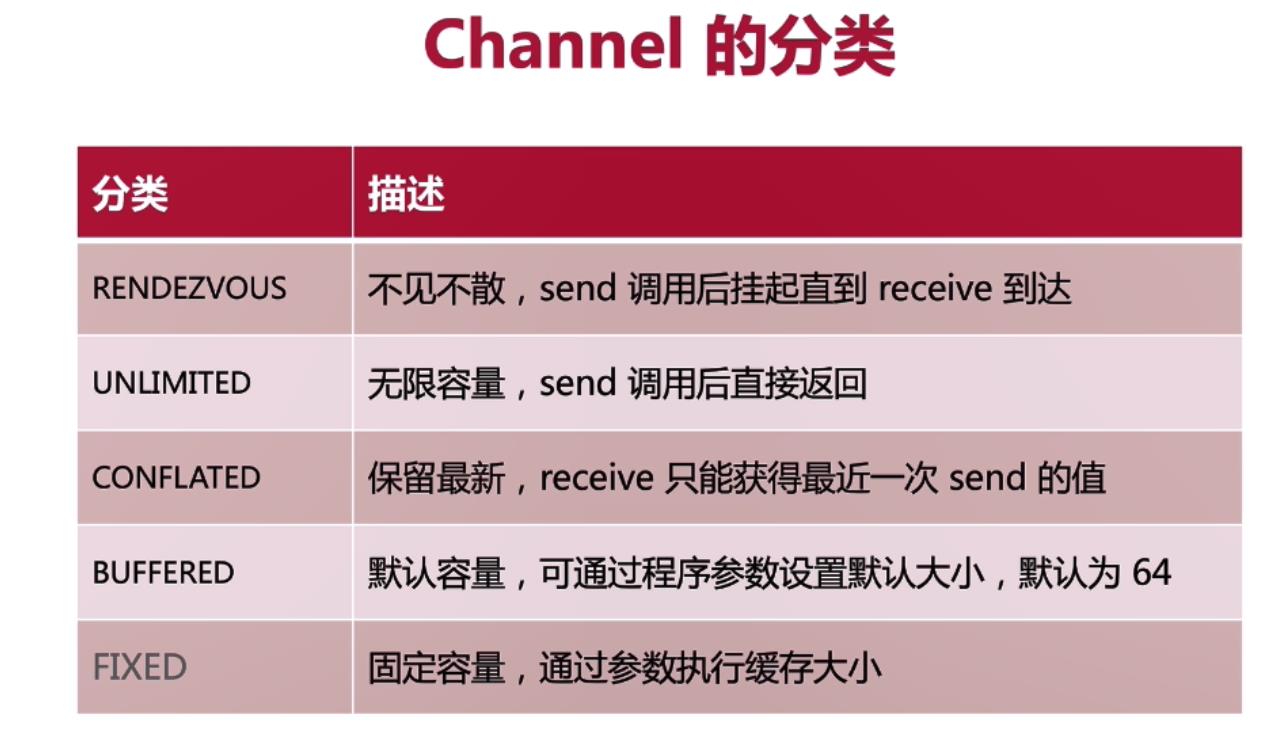
其中CONFLATED比较适合用于状态更新,比如进度条的进度,因为它总是只取最新的。
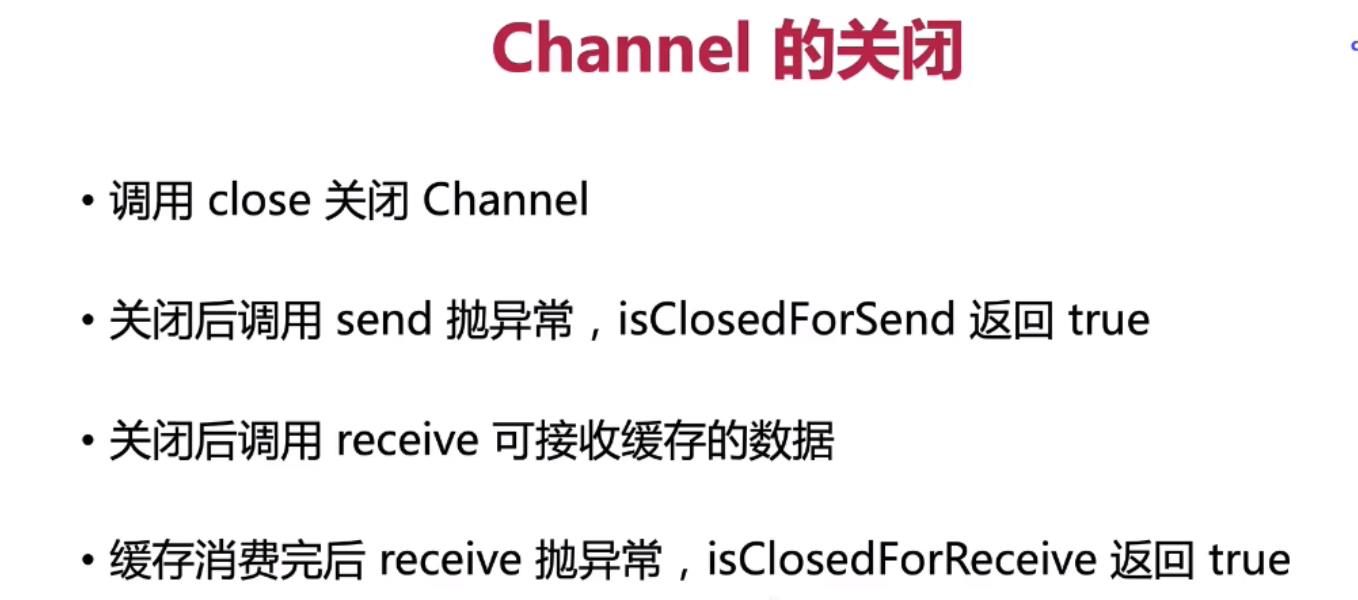

关闭后再发送会抛异常:

channel关闭后,channel中的数据仍然可以被接受,只有当channel中的数据消费完了,isClosedForReceive才为true.

suspend fun main()
basics()
suspend fun basics()
val channel = Channel<Int>(Channel.RENDEZVOUS)
// val channel = Channel<Int>(Channel.UNLIMITED)
// val channel = Channel<Int>(Channel.CONFLATED)
// val channel = Channel<Int>(Channel.BUFFERED)
// val channel = Channel<Int>(1)
//生产者 发
val producer = GlobalScope.launch
for (i in 0..3)
log("sending", i)
channel.send(i)
log("sent", i)
channel.close()
//消费者 收
val consumer = GlobalScope.launch
while (!channel.isClosedForReceive)
log("receiving")
val value = channel.receiveOrNull()
log("received", value)
producer.join()
consumer.join()
Channel(Channel.RENDEZVOUS ) 的方式是发一个收一个,边发边收,如果没有接受的,发送者会挂起等待,输出如下:
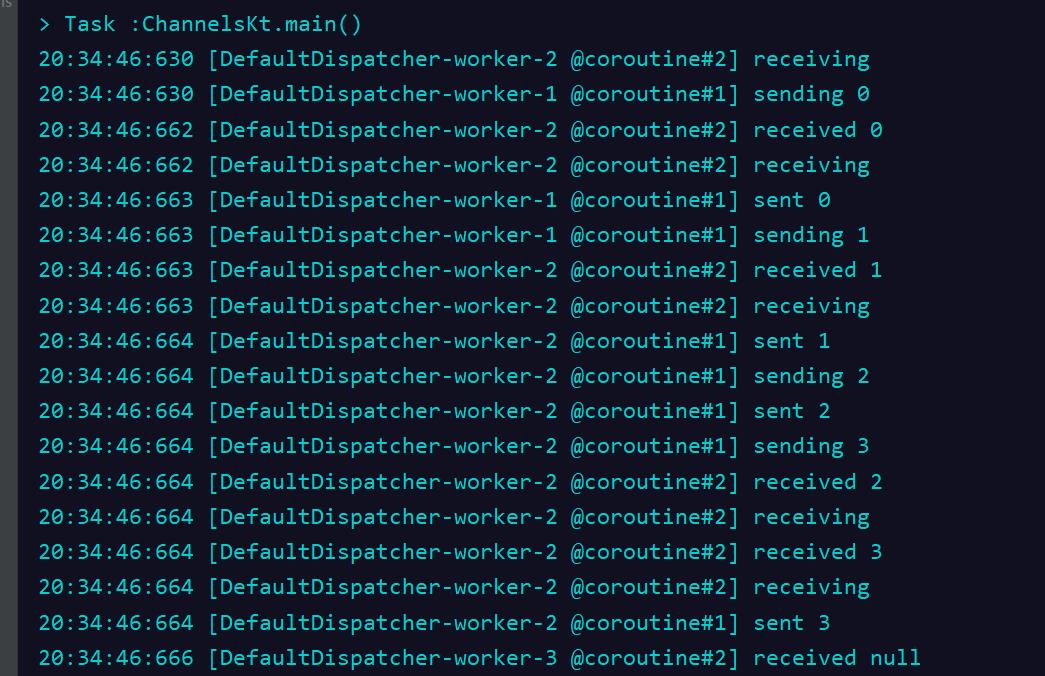
Channel(Channel.UNLIMITED ) 的方式是全部发送完毕,才会接收到,先发后收,发送者发送完就返回了,不管有没有接受者,输出如下: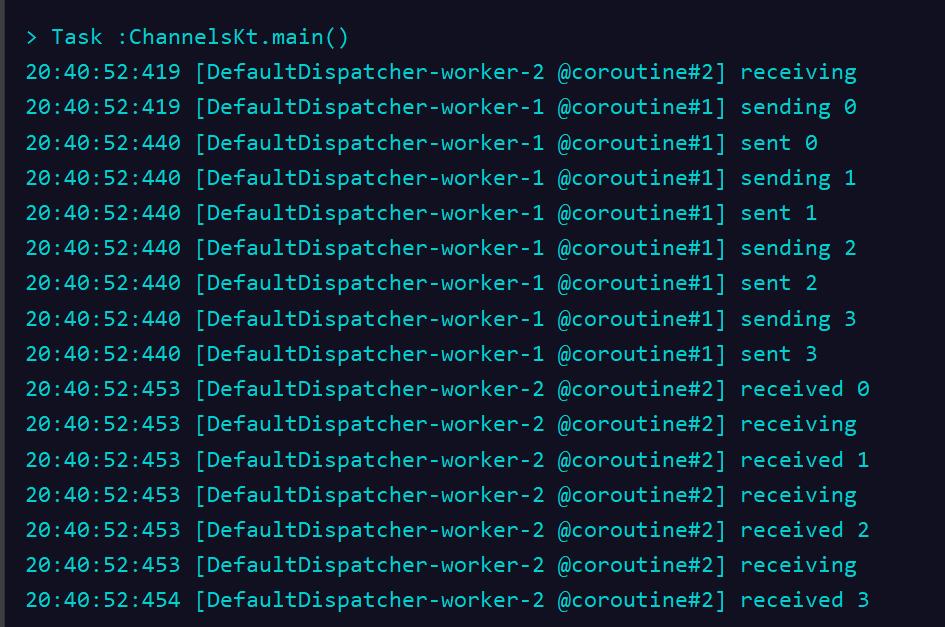
Channel(Channel.CONFLATED ) 的方式是不管发了多少个,只能收到最后一个,也是发送完就返回了,不管有没有接受者,输出如下:

Channel(Channel.BUFFERED ) 的方式也是发送者发送完就返回了,不管有没有接受者,可以指定buffer大小,输出如下:
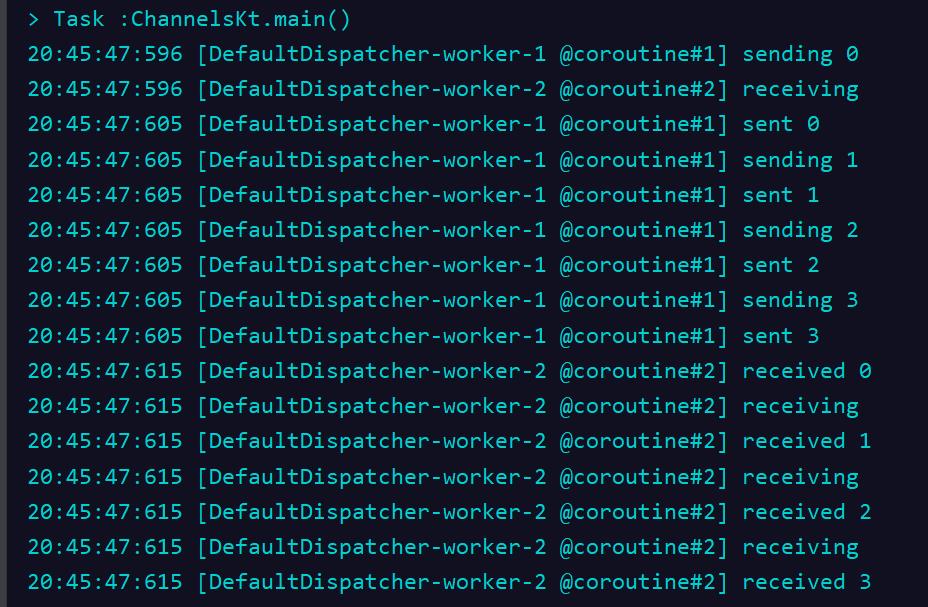
Channel(1) 的方式指定管道的容量大小,如果数据超过容量,发送者就会挂起等待,直到有接受者取走数据,发送者才发送下一批数据,


channel接受数据的时候可以直接当成迭代器使用:
suspend fun iterateChannel()
val channel = Channel<Int>(Channel.UNLIMITED)
val producer = GlobalScope.launch
for (i in 0..3)
log("sending", i)
channel.send(i)
log("sent", i)
channel.close()
val consumer = GlobalScope.launch
for (i in channel)
log("received: ", i)
producer.join()
consumer.join()
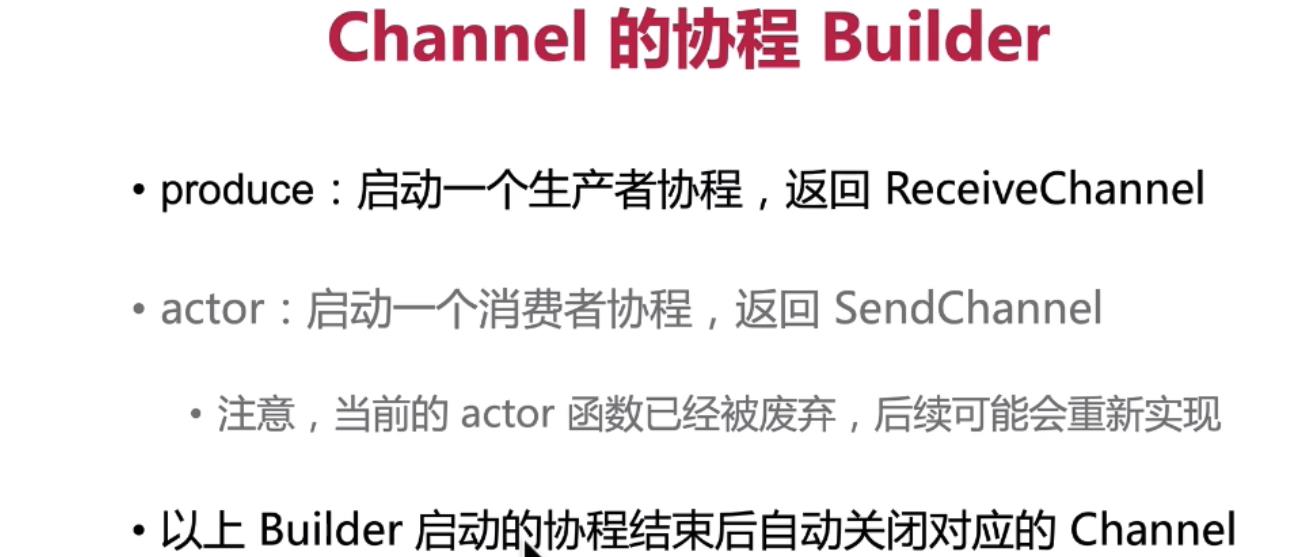
suspend fun producer()
val receiveChannel = GlobalScope.produce(capacity = Channel.UNLIMITED)
for (i in 0..3)
log("sending", i)
send(i)
log("sent", i)
val consumer = GlobalScope.launch
for (i in receiveChannel)
log("received: ", i)
consumer.join()
suspend fun consumer()
val sendChannel = GlobalScope.actor<Int>(capacity = Channel.UNLIMITED)
for (i in this)
log("received: ", i)
val producer = GlobalScope.launch
for (i in 0..3)
log("sending", i)
sendChannel.send(i)
log("sent", i)
producer.join()

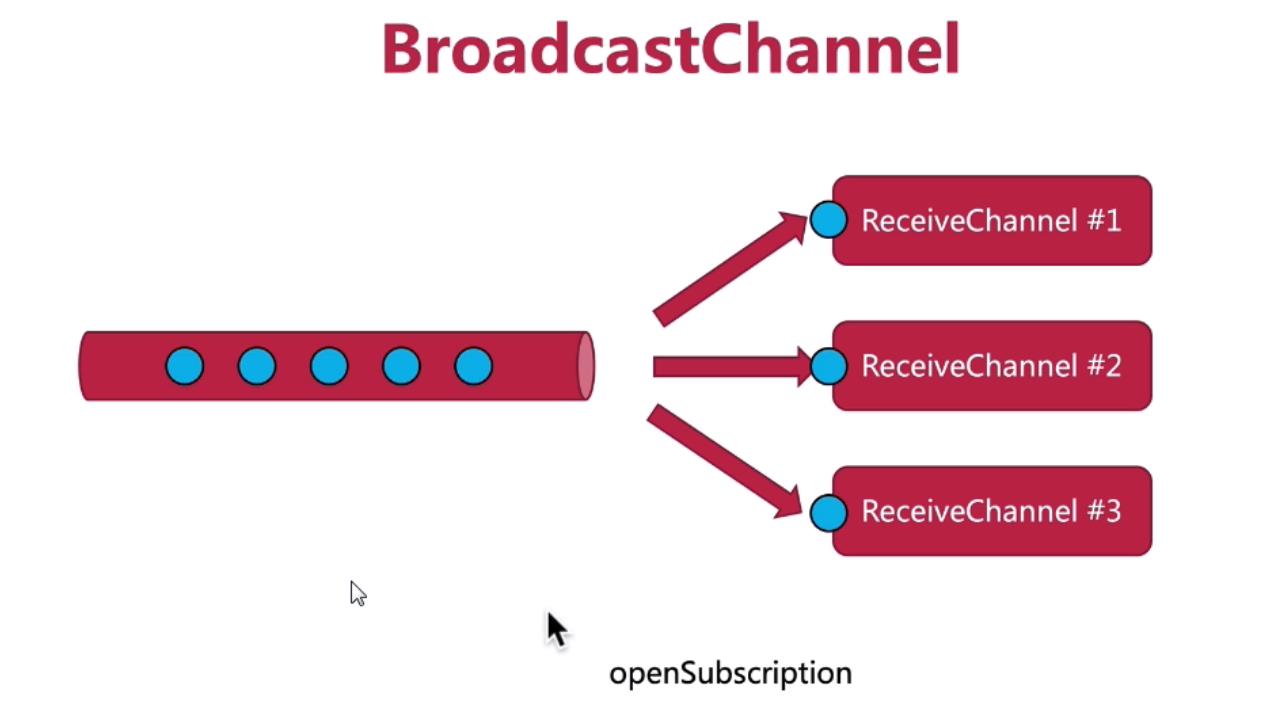
suspend fun broadcast()
//下面几种都可以创建一个BroadcastChannel
//val broadcastChannel = BroadcastChannel<Int>(Channel.BUFFERED)
//val broadcastChannel = Channel<Int>(Channel.BUFFERED).broadcast()
val broadcastChannel = GlobalScope.broadcast
for (i in 0..5)
send(i)
//启动5个接受者,每个都能收到
List(5) index ->
GlobalScope.launch
val receiveChannel = broadcastChannel.openSubscription()
for (i in receiveChannel)
log("[#$index] received: $i")
.joinAll()
输出:
> Task :ChannelsKt.main()
21:07:12:924 [DefaultDispatcher-worker-3 @coroutine#2] [#0] received: 0
21:07:12:924 [DefaultDispatcher-worker-5 @coroutine#6] [#4] received: 0
21:07:12:924 [DefaultDispatcher-worker-1 @coroutine#3] [#1] received: 0
21:07:12:925 [DefaultDispatcher-worker-4 @coroutine#5] [#3] received: 0
21:07:12:925 [DefaultDispatcher-worker-2 @coroutine#4] [#2] received: 0
21:07:12:944 [DefaultDispatcher-worker-1 @coroutine#3] [#1] received: 1
21:07:12:943 [DefaultDispatcher-worker-3 @coroutine#2] [#0] received: 1
21:07:12:943 [DefaultDispatcher-worker-5 @coroutine#6] [#4] received: